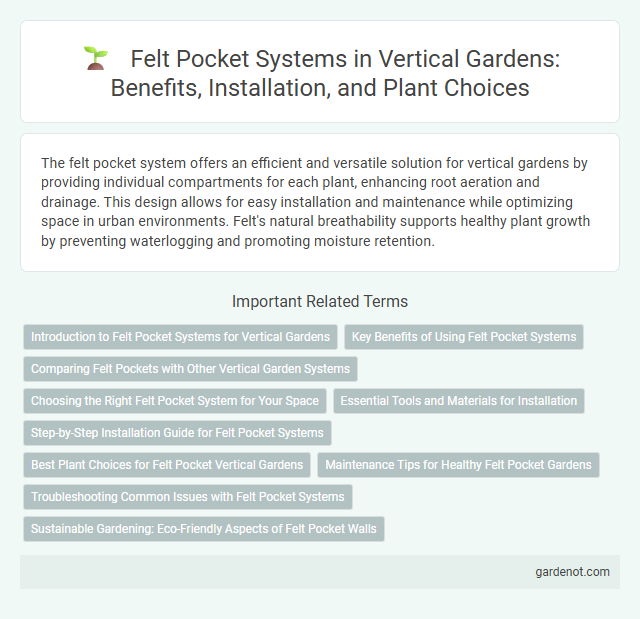The felt pocket system offers an efficient and versatile solution for vertical gardens by providing individual compartments for each plant, enhancing root aeration and drainage. This design allows for easy installation and maintenance while optimizing space in urban environments. Felt's natural breathability supports healthy plant growth by preventing waterlogging and promoting moisture retention.
Introduction to Felt Pocket Systems for Vertical Gardens
Felt pocket systems for vertical gardens utilize durable, breathable felt fabric pockets to house plants securely on vertical surfaces, optimizing space and promoting healthy root growth. These systems enable efficient water retention and air circulation, supporting a diverse range of plant species in urban and indoor environments. Their modular design allows for easy installation and maintenance, making them a popular choice for sustainable living walls and greenery integration in compact spaces.
Key Benefits of Using Felt Pocket Systems
Felt pocket systems in vertical gardens enhance plant growth by improving air circulation and water retention within each pocket, creating an optimal microenvironment for roots. Their lightweight, breathable materials reduce soil compaction and support diverse plant species, fostering healthier, more vibrant green walls. Easy installation and modular design also enable efficient maintenance and scalability for indoor and outdoor vertical gardening projects.
Comparing Felt Pockets with Other Vertical Garden Systems
Felt pocket systems offer superior water retention and breathability compared to traditional plastic or metal vertical garden structures, promoting healthier root growth and reducing water usage. Unlike rigid frameworks, felt pockets allow for flexible plant arrangement and easier installation on various surfaces, enhancing vertical gardening versatility. The eco-friendly materials in felt pockets also contribute to sustainability, outperforming synthetic alternatives in environmental impact and durability.
Choosing the Right Felt Pocket System for Your Space
Selecting the right felt pocket system for your vertical garden depends on factors such as wall size, plant type, and environmental conditions. Opt for high-quality, breathable felt that ensures proper drainage and root aeration, promoting healthy plant growth. Consider modular designs to allow easy customization and expansion, fitting both small indoor areas and large outdoor walls.
Essential Tools and Materials for Installation
Installing a vertical garden with a felt pocket system requires essential tools such as a drill, screws, a measuring tape, and a level to ensure precise placement and secure mounting. High-quality felt pockets made from durable, breathable material are crucial for proper root aeration and water drainage. Additionally, using strong anchors and waterproof backing materials helps maintain structural integrity and prevent moisture damage to walls.
Step-by-Step Installation Guide for Felt Pocket Systems
Begin the felt pocket system installation by securely mounting a sturdy backing board on the chosen wall, ensuring it can support the weight of the filled pockets. Attach the individual felt pockets evenly across the board using strong, weather-resistant fasteners, maintaining proper spacing for plant growth and water drainage. Finish by filling each pocket with a suitable vertical garden soil mix and introducing plants tailored for vertical growth, followed by consistent watering to promote healthy root development.
Best Plant Choices for Felt Pocket Vertical Gardens
Succulent varieties such as Echeveria and Sedum thrive in felt pocket vertical gardens due to their low water requirements and shallow root systems, ensuring long-term health and minimal maintenance. Herbs like thyme, mint, and oregano adapt well to felt pockets, providing both aesthetic appeal and functional culinary benefits. Ferns and small flowering plants such as petunias also complement the felt material by retaining moisture and enhancing the garden's vertical texture.
Maintenance Tips for Healthy Felt Pocket Gardens
Maintaining a healthy felt pocket garden involves regular watering, ensuring the felt remains consistently moist but not waterlogged to prevent root rot. Routine inspection for pests and trimming dead foliage encourages robust plant growth and airflow. Periodic fertilization with a balanced, water-soluble fertilizer supports nutrient uptake essential for lush vertical garden development.
Troubleshooting Common Issues with Felt Pocket Systems
Felt pocket systems in vertical gardens may face issues such as uneven water distribution, root rot, and pests due to poor drainage or overwatering. To troubleshoot, ensure proper irrigation setup with drip emitters, improve aeration by spacing pockets adequately, and inspect regularly for signs of infestation. Using high-quality, breathable felt material helps maintain moisture balance and supports healthy plant growth.
Sustainable Gardening: Eco-Friendly Aspects of Felt Pocket Walls
Felt pocket systems promote sustainable gardening by utilizing recycled materials that reduce environmental impact and support water conservation through efficient moisture retention. These eco-friendly vertical gardens enhance urban green spaces by maximizing limited areas while minimizing soil use and waste. Their biodegradability and reusability make felt pocket walls a responsible choice for environmentally conscious gardeners.
Felt pocket system Infographic

 gardenot.com
gardenot.com